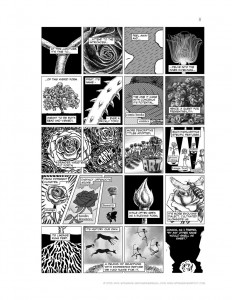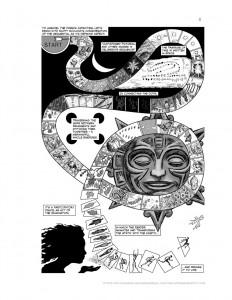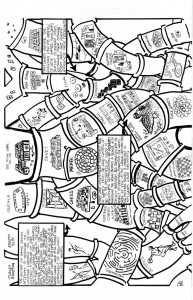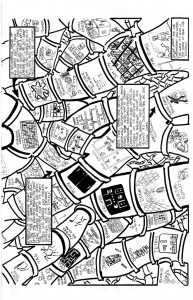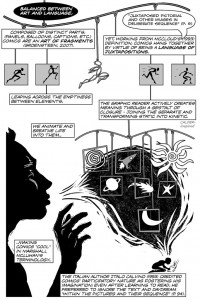At last, two long overdue pages! Very pleased with what emerged and worth all the time they took.
The first page addresses what to call this thing? I have this conversation all the time: “I’m doing my dissertation in comics form.” Confused response, “Oh, you mean graphic novels?” “Yes, that.”
It seemed like at some point I had to address that question in the dissertation as I started to discuss the specifics of the medium I’m working in itself. Initially, I’d thought about a page or two outlining the lineage of visual storytelling and making some sort of map around it – akin to what I did years ago to map the history of games in the Possibilities comic (See below). Ultimately I decided Scott McCloud had addressed so well this already, as had Lancelot Hogben in his 1949 book “From Cave Paintings to Comic Strips.” Instead, I opted to play with visual and verbal metaphors (more similar to the Rabbit page also from Possibilities) and explore the fact that the name is less important than what it does. And that speaks more to the point of this chapter – an exploration of how visual and verbal modes work differently and how they can work together…
The second page, begins to lay out my thinking on how comics work (reworking and expanding on my piece the shape of our thoughts). Specifically, I’m starting with McCloud’s definition and the sequential aspect of comics, before I move on and address their simultaneous properties on the following page. A lot of this rethinking and wrestling with McCloud’s and others’ notions on the sequential nature of comics has come in a big way from thinking with my students. If you compare this to the similar page in the shape of our thoughts earlier piece, you’ll see an evolution in my perspective on this. What I felt is most important about the sequential comes down to McCloud’s notion that time=space and the reader’s participatory role in stitching the fragments together. My initial design thoughts had to do with a sequence of events – ala Mousetrap or Rube Goldberg event – but I felt the relied too much on seeing the simultaneity of the page, which I didn’t want to get to yet. And then, the idea of the seasons struck me – and their very clear sequential nature – and seemed like the perfect way to demonstrate this idea naturally. This then led me to make the connection to ancient calendars – as a means of recording the passage of time in space. These earliest notations – not all that unlike comic books – were so necessary to early peoples to time crops to celebrate the coming of longer days to come and more. The behind the scene notation mark near the upper right is a redrawing of a paleolithic lunar calendar, and it’s right edge juxtaposes with a sequence of the sun setting on the solstice at Stone Henge – time quite literally written in space. I had a lot of synchronicity making this – my mom happened to send me pictures of maple icicles on the tree in front of our house, and I was already working icicles into the sequence. In telling stories to represent the seasons changing, I got the chance to work my dog in again! as we observe Orion and I’m particularly excited about the intersection of fall and spring as represented in the maple leaves sprouting and falling from the tree limb. There are a lot more stories unfolding and metamorphosizing throughout the winding path – but I’ll keep quiet and invite you to explore… – Nick
(As always, these are low-res versions of my pages – in the case of the sequence page, that may make the detail more than a little difficult to see… Sorry about that. When it gets to print – all will be sharp!)
From Possibilities 2006, pages on the history of games. What I didn’t do here.
My page on the sequential nature of comics from “The Shape of Our Thoughts” for comparison.


